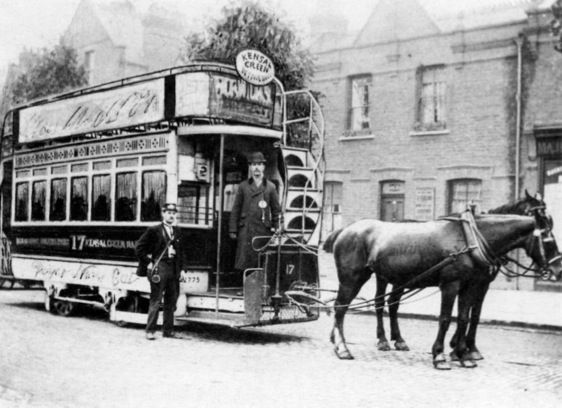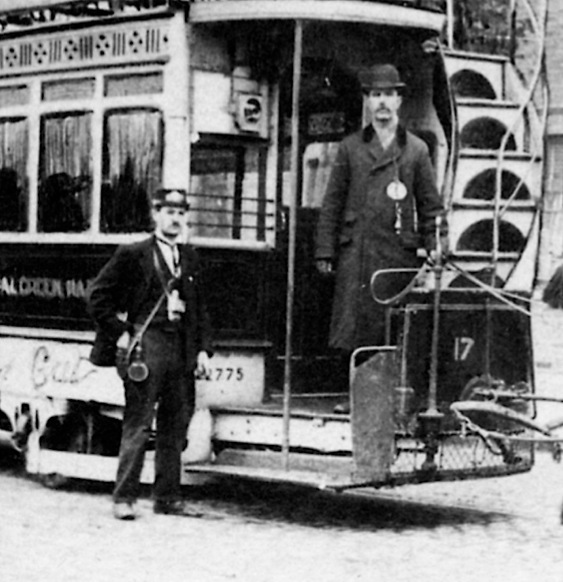Harrow Road and Paddington Tramways
History
The origin of the Harrow Road and Paddington Tramway lay in a much larger scheme that was submitted to Parliament in 1886 as the Cricklewood, Kilburn and Harrow Road Tramways Bill. However, due to objections, several sections of the bill were struck out, authorisation only being given for 2.97 miles of tramway. The bill was passed into law on the 25th June 1886 as the Harrow Road and Paddington Tramways Act, 1886, which also incorporated a company — the Harrow Road and Paddington Tramways Company — to build and operate the tramway.
It seems to have taken some time to raise the necessary finance, as the tramway did not open until the 7th July 1888, just over two years later, which exceeded the time allowed by the act for construction, so some sort of dispensation for the overrun may have been sought. The standard-gauge horse tramway was 2.78 miles long, which was slightly shorter than the total authorised. Although several attempts were made to extend it, it remained 'as built' throughout its entire existence.
From a terminus outside the Royal Oak public house in Harlesden, the tramway ran roughly southeastwards along Harrow Road, past Kensal Green Station, to a terminus just short of Lock Hospital Bridge (over the Grand Junction Canal) at the junction with Amberley Road; just before the terminus, a short line branched off northwards along Chippenham Road and Cambridge Road to a terminus outside the Prince of Wales public house.
The initial services were worked by 12 horsecars, the fleet expanding and contracting over the years, comprising 21 vehicles by 1901.
in 1891, the HR&PTCo applied for powers to build just over 6 miles of new lines, to the west, to the north and to the east, but due to various objections only received authorisation for 1.8 miles. Powers for the new lines, and to abandon the unbuilt sections in the original act, were granted on the 28th July 1891 under the Harrow Road and Paddington Tramways Act, 1891. By this time, however, it would appear that the company had ceased to run services over the branch line along Chippenham and Cambridge Roads, other than an occasional one to ensure that the company retained its statutory powers. It is unclear why the regular services were withdrawn, but most likely it was because they were unremunerative. The company presumably hoped to make the line profitable by extending northwards to Kilburn High Road, but for some reason, the authorised extension, and indeed any of the authorised extensions, were not built, despite the company twice applying for extensions to the time allowed for construction, under the Harrow Road and Paddington Tramways Acts of 1893 and 1894, which received their Royal Assents on the 9th June, and the 3rd July, respectively.
The main line continued to operate throughout the 1890s and into the early 1900s, by which time it had become the focus of electrification schemes. The company was approached by the British Electric Traction Company, which had, since the late 1890s, been aggressively purchasing horse and steam-operated tramways across the British Isles with the intention of converting them to electric traction, as well as promoting schemes for completely new electric tramways. Following negotiations with the BETCo, the HR&PTCo applied for powers to work the line with mechanical power, all presumably financed by the BETCo, on the understanding that the reconstructed tramway would be leased to the Metropolitan Electric Tramways Limited, a subsidiary of the BETCo. Powers were duly granted on 11th August 1903, under the Harrow Road and Paddington Tramways Act, 1903.
However, prior to the bill passing into law, agreement was formally reached, on the 13th June 1903, to sell the new powers and the tramway to the METL rather than leasing it, as was stipluated in the coming act. Another bill was therefore submitted to authorise the sale of the undertaking to the METL; this was passed into law on the 22nd July 1904 under the Harrow Road and Paddington Tramways Act, 1904.
The company continued to work the horse tramway until the 16th August 1906, when the tramway formally passed into the hands of the METL. The latter then worked the tramway for a mere two weeks before operational challenges stemming from the conversion to overhead electric traction led to the withdrawal of the horse-drawn services (on the 1st September 1906). The first electric services, operated by the METL, commenced on the 22nd December 1906.
Uniforms
Despite operating in the capital city for around 18 years (1888 to 1906), photographs of the Harrow Road and Paddington Tramways are extremely rare. Fortunately, one reasonably good shot of a horsecar and its crew has survived (see below), and this indicates that drivers and conductors wore informal but robust attire — trousers, overcoats, jackets, waistcoats, shirts and ties. Although drivers wore the ubiquitous bowler hat (a favourite of the profession), conductors were seemingly issued with a kepi-style cap, which bore a large badge, probably of pressed metal. Details of this badge are unclear, as none are known to have survived.
Both drivers and conductors wore Public Carriage Office licence badges when working. The badges, which were issued by the Metropolitan Police (see link), consisted of a large enamelled metal oval bearing the grade and a unique number; they were usually suspended from the bearer's jacket, overcoat or cash bag, by a leather strap.
Further reading
For a history of the Harrow Road and Paddington Tramways, see: 'Metropolitan Electric Tramways, Origins to 1920, Volume 1' by C S Smeeton; Light Rail Transit Association (1984).
Images
Horse tram drivers and conductors
The crew of Harrow Road and Paddington Tramways Company Horsecar No 17 pose for the camera with a service for Kensal Green — photo undated, but probably taken in the 1890s or early 1900s. Although the nearer horse appears slightly emaciated by modern standards, this seems to have been far from unusual for late-Victorian tramway horses. Photo courtesy of the Tramways and Light Railway Society, with thanks to David Voice.
An enlargement of the above photograph showing the conductor and the driver. The former is wearing a kepi-style cap, which bears a large plate-type cap badge, probably of pressed metal, whilst the driver sports the fashionable headgear of the time, the bowler hat. Both men are wearing prominent PCO licence badges, though neither appears to be wearing a formally issued jacket or overcoat; the conductor's licence badge is suspended from his cash-bag strap.